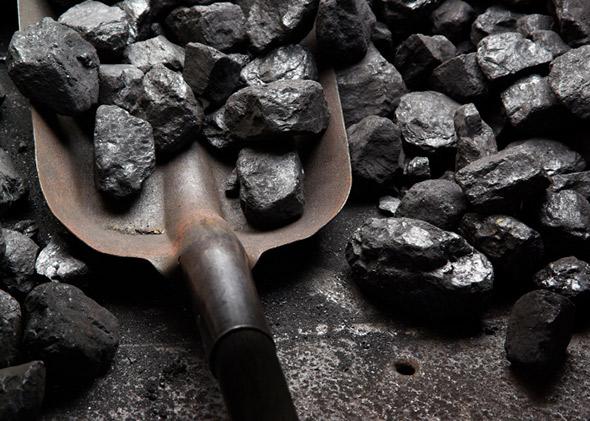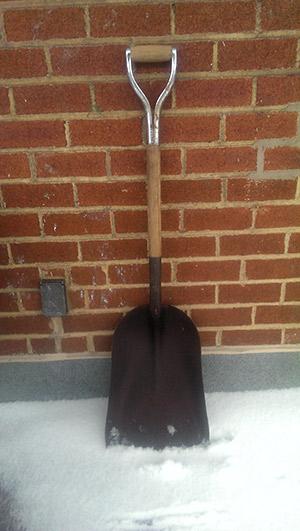Tomorrow morning I’ll head downstairs to dig my car out of the snow. I’ll have a stoic look on my face, and a warm sense of superiority in my heart. That’s because in my hands I’ll be holding a supreme weapon: an old steel coal shovel. There’s no finer tool for the task of shoveling snow—especially when that “snow” is in fact that unique urban concretion of ice, sand, and salt.
I got my shovel for five bucks a few years ago at a junk shop. I didn’t even own a car at the time; it was just a handsome and well-made tool, and I figured I’d find a good use for it someday. Now that I have, I pity the poor souls I see in my Queens neighborhood, hacking away at frozen drifts with flimsy plastic shovels. They bounce off the ice with a dispiriting, crumpling clunk, like an empty milk jug crushed underfoot. My trusty blade slices through the thickest crust with a pleasing, hissing shuuuuck. It is Excalibur to their sporks. I’m often completely dug out before they excavate their first wheel.
The coal shovel works so well, in fact, that I began to think it might have been designed for the job. And it turns out that, in a sense, it was.
In 1911, Frederick Winslow Taylor published The Principles of Scientific Management, the seminal work of the now ubiquitous field. Taylor used empirical methodology to improve business’ efficiency and profitability, and one of the first objects of his study was the shoveling of coal and other common industrial materials. At the Bethlehem Steel plant, he measured the tonnage shifted daily by handpicked “first-class men.” At the time, they were using standardized shovels that scooped between 5 and 40 pounds per load, depending on the density of the material they were working with. But the ideal shovel, Taylor determined, would scoop 21 pounds, be it of coal, pig iron, or anything else. At that weight, a first-class man could shift 59 tons in an eight-hour shift—a nearly four-fold improvement over the 16 tons per shift that Bethlehem then averaged. The company quickly adopted “8 to 10 different kinds of shovels … each one appropriate to handling a given type of material” and varied in size to scoop the standard 21 pounds.
For Bethlehem Steel, the effects were dramatic. It was able to reduce its workforce of shovelers from between 400 and 600 to just 160. Its labor costs per ton shoveled dropped from 7.2 to 3.3 cents. Its profits accordingly soared.
Workers, too—the ones who were left—saw an improvement in their absolute earnings, from $1.15 to $1.88 per day. But, quite sensibly, many of them didn’t feel particularly blessed. For nearly quadrupling their workload, they had increased their earnings by barely more than a half measure. (A raise that Taylor had decided was scientifically optimal, too. “When in return for this extra effort they are paid wages up to 60 per cent. beyond the wages usually paid,” he wrote, “this increase in wages tends to make them not only more thrifty but better men in every way; that they live rather better, begin to save money, become more sober, and work more steadily. When, on the other hand, they receive much more than a 60 per cent. increase in wages, many of them will work irregularly and tend to become more or less shiftless, extravagant, and dissipated. Our experiments showed, in other words, that it does not do for most men to get rich too fast.”)

Photo by Philip Hens/Thinkstock
Helped, no doubt, by that judgment, “Taylorism” soon became a divisive element in the era’s fierce battles between laissez-faire capitalists and progressive workers. Today, the tensions Taylor’s work introduced continue to define the adversarial relationship between management and labor.
Taylor’s other legacy, the scientific shovel, also endures. My coal shovel is the most familiar example. Its ideal physical form reflects the exacting measurements he took more than a century ago. Its rectangular shape and gently flared sides are perfect for scooping loose material. Its long but relatively narrow blade cuts easily into hard stuff like coal.
And ice. In a 2011 Slate piece on snow shovel death and how to avoid it, Timothy Noah noted that ergonomic snow shovels exist, and haven’t been shown to work particularly well. He wasn’t too high on the coal shovel either, at least for older shovelers with weak hearts. But I’d argue that, if health isn’t a concern, the coal shovel is the perfect tool for the task. Compare its silhouette to the squat, wide form of a snow shovel, and it becomes clear that a snow “shovel” is really a plow. The coal shovel’s short handle gives the user precise control of the blade, a useful thing when swinging the shovel near coworkers—and cars.
I have not measured the weight of ice-salt-sand that I shift with every shovelful. But I can attest that it’s easy, almost instinctively so, to get into a fast and effortless rhythm when digging out my car. I pull the shovel back across my right shoulder, then let its weight accelerate the blade through the snow and back up, flinging the load over my left shoulder at the top of the arc. The work goes fast. It’s even pleasant. Just one word of caution: A blade that will cut through coal will also cut through a bumper. So go get yourself a coal shovel. Just be careful around the bodywork.
